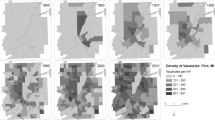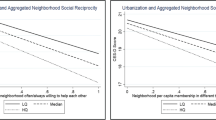Abstract
Purpose
Few studies consider the associations between neighborhood social capital and immigrant’s mental health. We examined associations between bonding, bridging and linking social capital and depression among immigrants in Toronto neighborhoods.
Methods
We used data on immigrants from the neighborhood effects on health and well-being (NEHW) study, conducted in 47 randomly selected greater Toronto area neighborhoods (sample = 916), and a study of one low-income, immigrant receiving neighborhood (IRN) (sample = 600). We conducted logistic regression models for depression (Epidemiologic Studies Depression Scale, CES-D) and social capital types: bonding (social cohesion and informal social control), bridging (group membership) and linking (engagement in political activities), while adjusting for different covariates.
Results
The prevalence of depression was 22.9 % in IRN and 21.4 % in NEHW. The associations between social capital types and depression differed in each sample. Lower social cohesion (bonding) was associated with higher depression in NEHW only. Lower linking social capital (never participated in political activities) was associated with lower depression in IRN only. These associations were consistent after adjustment for different covariates.
Conclusions
Results suggest that social cohesion might have a protective effect from depression among immigrants in NEHW. In IRN, lower linking social capital associated with lower depression might reflect opposite direction association. Bridging social capital was not associated with depression in either sample, indicating that current community building might be insufficient to impact depression. Different pathways might explain how depression among immigrants is impacted by social capital types operating in different neighborhood settings; this could be examined in future longitudinal studies.
Similar content being viewed by others
References
Statistics Canada (2013) Immigration and ethnocultural diversity in Canada: analytical document. National household survey. Minister of Industry, Ottawa
Kirmayer LJ, Narasiah L, Munoz M, Rashid M, Ryder AG, Guzder J, Hassan G, Rousseau C, Pottie K (2011) Common mental health problems in immigrants and refugees: general approach in primary care. CMAJ Can Med Assoc J 183(12):E959–E967. doi:10.1503/cmaj.090292
Ng E, Omariba W (2010) Is there a healthy immigrant effect in mental health? Evidences from population-based health surveys in Canada. Canadian Issues: Immigrant Mental Health, pp 23–28. Summer
Subedi RP, Rosenberg MW (2014) Determinants of the variations in self-reported health status among recent and more established immigrants in Canada. Soc Sci Med 115:103–110. doi:10.1016/j.socscimed.2014.06.021
Golding J, Burnam M (1990) Immigration, stress, and depressive symptoms in a Mexican-American community. J Nerv Ment Dis 178(3):161–171
Brisson DS, Usher CL (2005) Bonding social capital in low-income neighborhoods. Fam Relat 54(5):644–653
Stafford M, Newbold BK, Ross NA (2011) Psychological distress among immigrants and visible minorities in Canada: a contextual analysis. Int J Soc Psychiatry 57(4):428–441. doi:10.1177/0020764010365407
Kawachi I, Berkman L (2000) Social cohesion, social capital, and health. In: Berkman L, Kawachi I (eds) Social epidemiology. Oxford University Press, New York, p 175
Putnam RD (2001) Bowling alone: the collapse and revival of American community. Simon and Schuster, New York
Portes A (1998) Social capital: its origins and applications in modern sociology. Annu Rev Sociol 24(1):1–24
Coleman JS (1994) Foundations of social theory. Harvard University Press, US
Bourdieu P (1986) The forms of capital. In: Richardson J (ed) Handbook of theory and research for the sociology of education. Greenwood, New York, US, pp 241–258
Alegría M, Molina KM, Chen C-N (2014) Neighborhood characteristics and different risk for depressive and anxiety disorders across racial/ethnic groups in the United States. Depress Anxiety 31(1):27–37. doi:10.1002/da.22197
Bécares L, Nazroo J, Stafford M (2009) The buffering effects of ethnic density on experienced racism and health. Health Place 15(3):700–708
Hou F, Wu Z (2009) Racial diversity, minority concentration, and trust in Canadian urban neighborhoods. Soc Sci Res 38(3):693–716
Pickett KE, Wilkinson RG (2008) People like us: ethnic group density effects on health. Ethn Health 13(4):321–334. doi:10.1080/13557850701882928
Beaudoin CE (2009) Bonding and bridging neighborliness: an individual-level study in the context of health. Soc Sci Med 68(12):2129–2136
Lee M-A (2009) Neighborhood residential segregation and mental health: a multilevel analysis on Hispanic Americans in Chicago. Soc Sci Med 68(11):1975–1984
Harpham T, Grant E, Rodriguez C (2004) Mental health and social capital in Cali, Colombia. Soc Sci Med 58(11):2267–2277. doi:10.1016/j.socscimed.2003.08.013
Macintyre S, Ellaway A (2000) Neighbourhood cohesion and health in socially contrasting neighbourhoods: implications for the social exclusion and public health agendas. Health Bull 58(6):450–456
Lin N (2001) Social capital: a theory of social structure and action. Cambridge University Press, New York
Durkheim E (1897/1952) Suicide: a study in sociology. Simpson G (ed) Edited with an introduction, Spaulding JA, Simpson G (trans). Free Press, New York
Putnam RD (1993) Making democracy work: civic traditions in modern Italy. Princeton University Press, Princeton
Blair A, Ross N, Gariepy G, Schmitz N (2014) How do neighborhoods affect depression outcomes? A realist review and a call for the examination of causal pathways. Soc Psychiatry Psychiatr Epidemiol 49(6):873–887. doi:10.1007/s00127-013-0810-z
Narayan D (1999) Bonds and bridges: social capital and poverty. Word Bank, Washington DC
Muntaner C, Lynch J (1999) Income inequality, social cohesion, and class relations: a critique of Wilkinson’s neo-Durkheimian research program. Int J Health Serv Plan Adm Eval 29(1):59–81
Muntaner C (2004) Commentary: social capital, social class, and the slow progress of psychosocial epidemiology. Int J Epidemiol 33(4):674–680. doi:10.1093/ije/dyh200 (discussion 700–674)
Szreter S, Woolcock M (2004) Health by association? Social capital, social theory and the political economy of public health. Int J Epidemiol 33:650–667
Harpham T, Grant E, Thomas E (2002) Measuring social capital within health surveys: key issues. Health Policy Plan 17(1):106–111
Stone W (2003) Towards building capacity and sustainable communities: bonding, bridging and linking with social capital. Bulletin 4:13–16
Cheong PH, Edwards R, Goulbourne H, Solomos J (2007) Immigration, social cohesion and social capital: a critical review. Crit Soc Policy 27(1):24–49. doi:10.1177/0261018307072206
Woolcock M (2003) Diversity as opportunity and challenge: the role of social capital theory, evidence and policy. In: Policy Research Initiative Conference, Montreal, Quebec
Mitchell CU, LaGory M (2002) Social capital and mental distress in an impoverished community. City Community 1(2):199–222. doi:10.1111/1540-6040.00017
Kim BJ, Auh E, Lee YJ, Ahn J (2013) The impact of social capital on depression among older Chinese and Korean immigrants: similarities and differences. Aging Ment Health 17(7):844–852. doi:10.1080/13607863.2013.805399
O’Campo P, Wheaton B, Nisenbaum R, Glazier RH, Dunn JR, Chambers C (2015) The neighbourhood effects on health and well-being (NEHW) study. Health Place 31c:65–74. doi:10.1016/j.healthplace.2014.11.001
American Psychiatric Association (1994) Diagnostic and statistical manual of mental disorders: DSM-IV-TR, 4th edn. American Psychiatric Association, Washington, DC (text rev)
Radloff L (1977) The CES-D scale: a self-report depression scale for research in the general population. Appl Psychol Meas 1977(1):385–401
Roberts RE, Vernon SW, Rhoades HM (1989) Effects of language and ethnic status on reliability and validity of the center for epidemiologic studies-depression scale with psychiatric patients. J Nerv Ment Dis 177(10):581–592
Eaton WW, Muntaner C, Smith C, Tien A, Ybarra M (2004) Center for epidemiologic studies depression scale: review and revision (CESD and CESD-R). In: Maruish ME (ed) The use of psychological testing for treatment planning and outcomes assessment, vol 3. Lawrence Erlbaum, Mahwah, pp 363–337
Kuo BC, Chong V, Joseph J (2008) Depression and its psychosocial correlates among older Asian immigrants in North America: a critical review of two decades’ research. J Aging Health 20(6):615–652. doi:10.1177/0898264308321001
van Buuren S, Boshuizen HC, Knook DL (1999) Multiple imputation of missing blood pressure covariates in survival analysis. Stat Med 18(6):681–694
Rubin D (1987) Multiple imputation for nonresponse in surveys. Wiley, New York
Ali J (2002) Mental health of Canada’s immigrants. Health Rep 13(Suppl):1–11
Turvey CL, Wallace RB, Herzog R (1999) A revised CES-D measure of depressive symptoms and a DSM-based measure of major depressive episodes in the elderly. Int Psychogeriatr IPA 11(2):139–148
Wu Z, Schimmele C (2005) The healthy migrant effect on depression: variation over time? Can Stud Popul 32(2):271–298
Kessler RC, Bromet EJ (2013) The epidemiology of depression across cultures. Annu Rev Public Health 34:119–138. doi:10.1146/annurev-publhealth-031912-114409
Kuo BC, Guan J (2006) Sociocultural predictors of depression for Chinese immigrant elderly in Canada: acculturation, relationship with adult children, social support, and perceived services barriers. Cambridge Scholars, New Castle
Be´cares L, Nazroo J, Stafford M (2011) The ethnic density effect on alcohol use among ethnic minority people in the UK. J Epidemiol Community Health 65:20–25
Mitchell CU, La Gory M (2002) Social capital and mental distress in an impoverished community. City Community 1(2):199–222
Kim D, Subramanian SV, Kawachi I (2006) Bonding versus bridging social capital and their associations with self rated health: a multilevel analysis of 40 US communities. J Epidemiol Community Health 60(2):116–122
Sampson R, Raudenbush S, Earls F (1997) Neighborhoods and violent crime: a multilevel study of collective efficacy. Science 277:918–924
De Silva MJ, Huttly SR, Harpham T, Kenward MG (2007) Social capital and mental health: a comparative analysis of four low income countries. Social Science & Medicine 64:5–20
Grootaert C, Narayan D, Jones VN, Woolcock M (2004) Measuring social capital: an integrated questionnaire World Bank Working Paper. The World Bank, Washington, DC
Acknowledgments
The NEHW study was funded by Canadian Institutes of Health Research (CIHR), Grant #MOP-84439, and the Social Science and Health Research Council (SSHRC), Grant #410-2007-1499. IRN research reported in this paper was supported in part by the Wellesley Institute, through their Immigrant Health Project, and by the Canadian Institute for Health Research (CIHR) Grant # 192226 (2008–09). Thanks to all IRN interviewers and field coordinators. Thanks also to the Survey Research Unit at the Centre for Research on Inner City Health (CRICH) for data collection.
Author information
Authors and Affiliations
Corresponding author
Ethics declarations
Conflict of interest
On behalf of all authors, the corresponding author states that there are no conflict of interest.
Rights and permissions
About this article
Cite this article
Daoud, N., Haque, N., Gao, M. et al. Neighborhood settings, types of social capital and depression among immigrants in Toronto. Soc Psychiatry Psychiatr Epidemiol 51, 529–538 (2016). https://doi.org/10.1007/s00127-016-1173-z
Received:
Accepted:
Published:
Issue Date:
DOI: https://doi.org/10.1007/s00127-016-1173-z




